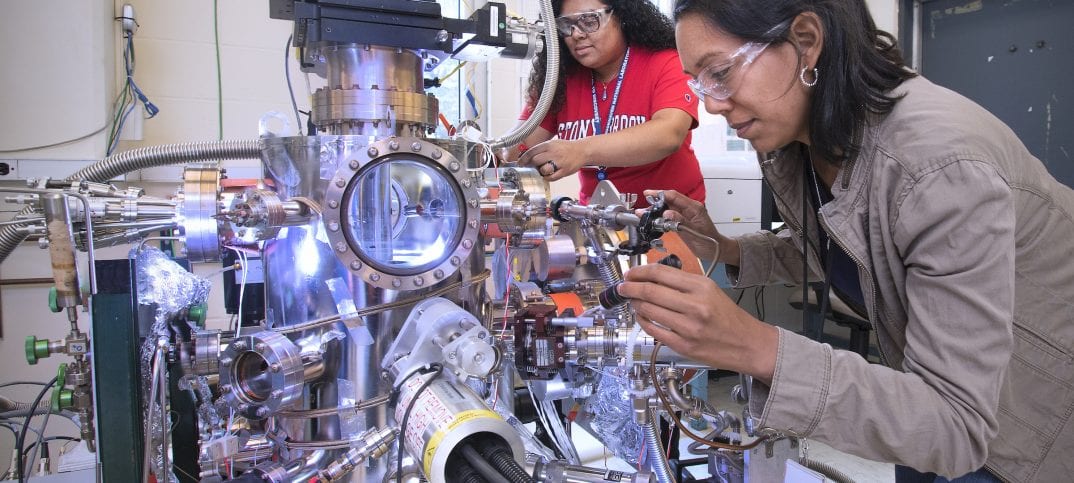By Daniel Dunaief
This article is part two in a two-part series.
Local medical and research institutions are aware of the challenges women face in science and are taking steps to ensure that women receive equal opportunities for success in science, technology, engineering and mathematics (or STEM). Times Beacon Record News Media reached out to members of each institution and received an overview of some initiatives.
Brookhaven National Laboratory
The Department of Energy-funded research facility has created a number of opportunities for women, including Brookhaven Women in Science. This effort has been active for over four decades and its mission, according to Peter Genzer, a BNL spokesman, is to support the development of models, policies and practices that enhance the quality of life for BNL employees and emphasize the recruitment, hiring, promotion and retention of women.
BWIS offers annual awards, outreach events and various networking opportunities in the lab and community, while the lab’s Talent Management Group partners with BWIS to bring classes and speakers to discuss issues specific to women.
In October, the group hosted Kimberly Jackson, a vice chair and associate professor of chemistry and biochemistry at Spelman College, who gave a talk titled “Realigning the Crooked Room in STEM.”
The Leona Woods Distinguished Postdoctoral Lectureship Award at BNL, meanwhile, celebrates the scientific accomplishments of female physicists, physicists from under-represented minority groups and LGBTQ physicists and to promote diversity and inclusion. BNL awarded the lectureship this year to Kirsty Duffy, a fellow at Fermi National Accelerator Laboratory.
For the past five years, BNL has also partnered with a local chapter of Girls Inc., which helps to “encourage young women towards careers” in STEM, Genzer explained in an email.
BNL has also collaborated with the Girl Scouts of Suffolk County to organize a new patch program that encourages Girl Scouts to work in scientific fields. As of September, county Girl Scouts can earn three new Brookhaven Lab patches, and the lab hopes to extend the program nationwide across the Department of Energy complex.
BNL also provides six weeks of paid time off at 100 percent of base pay for a primary caregiver after birth or adoption and one week of full pay for a secondary caregiver. BNL is exploring plans to enhance support for primary and secondary caregivers, Genzer said.
Cold Spring Harbor Laboratory
Cold Spring Harbor Laboratory has taken several recent steps as part of an ongoing effort to encourage gender diversity.
In October, a group of four CSHL administrators traveled to the University of Wisconsin in Madison to discuss mentoring. The goal was to train them on how to design and deliver mentoring training regularly to the faculty, postdocs and graduate students on campus, said Charla Lambert, the diversity, equity and inclusion officer for research at CSHL. The first version of the training will occur next spring. The ultimate goal is to ensure the research environment at CSHL emphasizes good mentoring practices and is more inclusive for all mentees.
CSHL has also hosted a three-day workshop in leadership practices for postdoctoral researchers and junior faculty since 2011. The workshop, which is run through the Meetings & Courses Program, trains about 25 postdoctoral researchers and junior faculty each year and has about one per year from CSHL, addresses how to hire and motivate people, while providing constructive feedback.
Lambert said family-friendly policies were already a part of CSHL policies, which include a child care facility. Members of the faculty receive extra funding when they travel to conferences to provide additional child care.
Lambert, who is a program manager for extramural Meetings & Courses overseeing diversity initiatives, has worked to get the demographic data for participants centralized, analyzed and used in developing policies. She believes this kind of data centralization is an area for potential improvement in the research division, where she is working to ensure an equitable distribution of resources among CSHL scientists.
Throughout her nine-year career at CSHL, Lambert said she has worked with the meetings and courses division to make sure the 9,000 scientists who visit the facility each year include women as invited speakers. She also works to reach course applicants from a wide range of institutions, including outside of prestigious research schools.
Ultimately, Lambert is hoping to help change the culture of science among the researchers with whom she interacts from a wide range of institutions. She feels that those people who leave the STEM fields because something about the culture of science didn’t work for them represent a “huge loss” to the field and creates a “survivorship bias.”
Stony Brook University
For Stony Brook, gender diversity is “very important,” said Latha Chandran, the vice dean for Academic and Faculty Affairs at the Stony Brook University Renaissance School of Medicine.
Chandran said more men entered the field of medicine 14 years ago. That has completely changed, as women have outnumbered their male counterparts in medicine for the last three or four years.
Chandran cited a number of statistics to indicate changes at the medical school. For starters, women faculty constituted 38 percent of the total in 2011. This April, that number climbed to 48.1 percent. That puts Stony Brook in the top 79th percentile of medical schools in terms of female representation.
While the overall numbers are higher, women are still underrepresented in the top tiers of the medical school, as 18 percent of the department chairs are women. She hopes more women can lead departments and that they can serve as role models that others can aspire to follow.
As for harassment, Chandran said Stony Brook was above the national mean in 2011. For almost all categories, Stony Brook is now below the national mean.
In 2011, Stony Brook created We Smile, which stands for We can Eradicate Student Mistreatment in the Learning Environment. The goal of this program is to educate people about harassment and to ensure that any mistreatment is reported. Through this effort, Stony Brook medical students are aware of the policies and procedures surrounding reporting.
Stony Brook is also addressing any bias in admission procedures by prospective applicants, who receive a standardized scenario to address with an admissions officer. In 2025, admissions officers will not have any information about the qualifications of the individual and will evaluate his or her response during interviews only based on response to scenarios.
Stony Brook University has almost finalized its search for a chief diversity candidate. Chandran expects that the medical school will “continue to make progress.”







